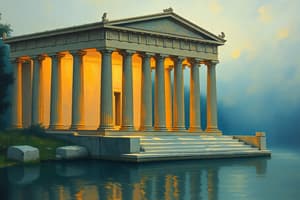Podcast
Questions and Answers
Which of the following describes a feature of the first stage of temple architecture development during the Gupta period?
Which of the following describes a feature of the first stage of temple architecture development during the Gupta period?
- The temples had a two-storied structure with a covered ambulatory passageway.
- The temples had a curved shikhara roof and were rectangular in shape.
- The temples had a flat roof and were square in shape. (correct)
- The temples followed the Panchayatana style with four subsidiary shrines.
Which of the following describes the Panchayatana style of temple architecture introduced in the third stage of development during the Gupta period?
Which of the following describes the Panchayatana style of temple architecture introduced in the third stage of development during the Gupta period?
- The main temple was two-storeyed with four smaller shrines on the lower level.
- The main temple had a shikhara roof and was accompanied by four subsidiary shrines. (correct)
- The main temple had a flat roof and was surrounded by four smaller shrines.
- The main temple was square-shaped with four subsidiary shrines arranged in a rectangular pattern.
Which of the following features was introduced in the second stage of temple architecture development during the Gupta period?
Which of the following features was introduced in the second stage of temple architecture development during the Gupta period?
- The addition of a covered ambulatory passageway around the sanctum sanctorum. (correct)
- The emergence of shikharas in place of a flat roof.
- The introduction of the Panchayatana style with subsidiary shrines.
- The construction of two-storeyed temples.
Which of the following statements accurately describes the progression of temple architecture during the Gupta period?
Which of the following statements accurately describes the progression of temple architecture during the Gupta period?
Which of the following examples is cited in the text as an instance of a temple from the first stage of development during the Gupta period?
Which of the following examples is cited in the text as an instance of a temple from the first stage of development during the Gupta period?
Which of the following statements is NOT true about the second stage of temple architecture development during the Gupta period?
Which of the following statements is NOT true about the second stage of temple architecture development during the Gupta period?
Which of the following features is NOT mentioned as a characteristic of the third stage of temple architecture development during the Gupta period?
Which of the following features is NOT mentioned as a characteristic of the third stage of temple architecture development during the Gupta period?
Which of the following statements accurately describes the mandap mentioned in the context of the Panchayatana style of temple architecture?
Which of the following statements accurately describes the mandap mentioned in the context of the Panchayatana style of temple architecture?
Based on the information provided in the text, which of the following statements is true about the development of temple architecture during the Gupta period?
Based on the information provided in the text, which of the following statements is true about the development of temple architecture during the Gupta period?
Which of the following examples is cited in the text as an instance of a temple from the second stage of development during the Gupta period?
Which of the following examples is cited in the text as an instance of a temple from the second stage of development during the Gupta period?
Flashcards are hidden until you start studying




